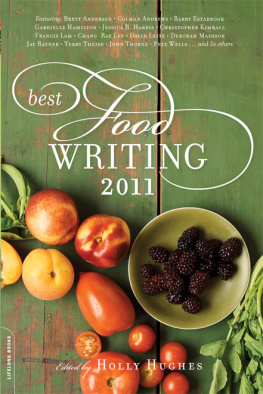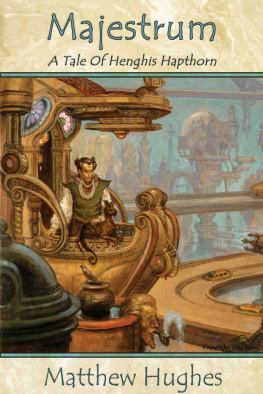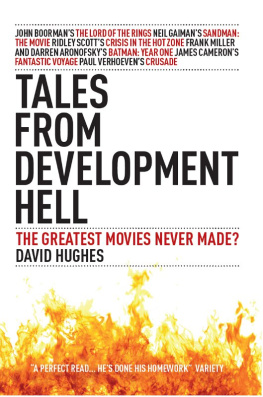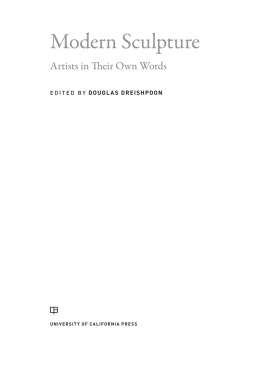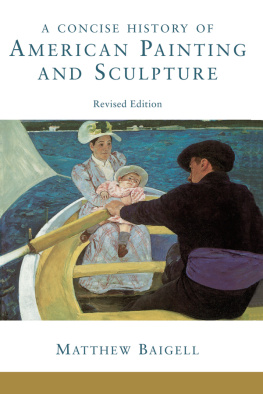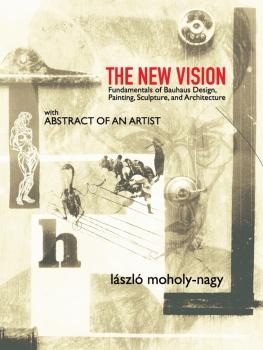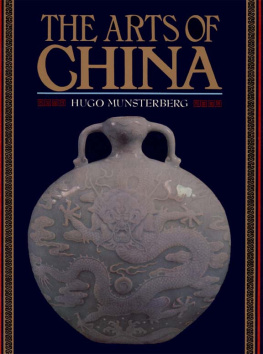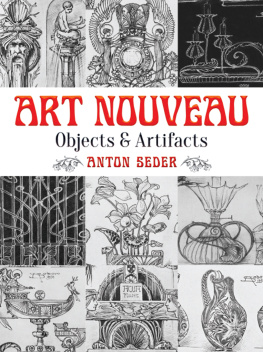Hughes - The Shock of the new
Here you can read online Hughes - The Shock of the new full text of the book (entire story) in english for free. Download pdf and epub, get meaning, cover and reviews about this ebook. year: 1991, publisher: Knopf Doubleday Publishing Group;Alfred A. Knopf, genre: Art. Description of the work, (preface) as well as reviews are available. Best literature library LitArk.com created for fans of good reading and offers a wide selection of genres:
Romance novel
Science fiction
Adventure
Detective
Science
History
Home and family
Prose
Art
Politics
Computer
Non-fiction
Religion
Business
Children
Humor
Choose a favorite category and find really read worthwhile books. Enjoy immersion in the world of imagination, feel the emotions of the characters or learn something new for yourself, make an fascinating discovery.

The Shock of the new: summary, description and annotation
We offer to read an annotation, description, summary or preface (depends on what the author of the book "The Shock of the new" wrote himself). If you haven't found the necessary information about the book — write in the comments, we will try to find it.
Abstract: An illustrated history of modern art describes the origins of modern painting, sculpture, and architecture, shows how world events affected the art, and explains why the movement is near its end
The Shock of the new — read online for free the complete book (whole text) full work
Below is the text of the book, divided by pages. System saving the place of the last page read, allows you to conveniently read the book "The Shock of the new" online for free, without having to search again every time where you left off. Put a bookmark, and you can go to the page where you finished reading at any time.
Font size:
Interval:
Bookmark:
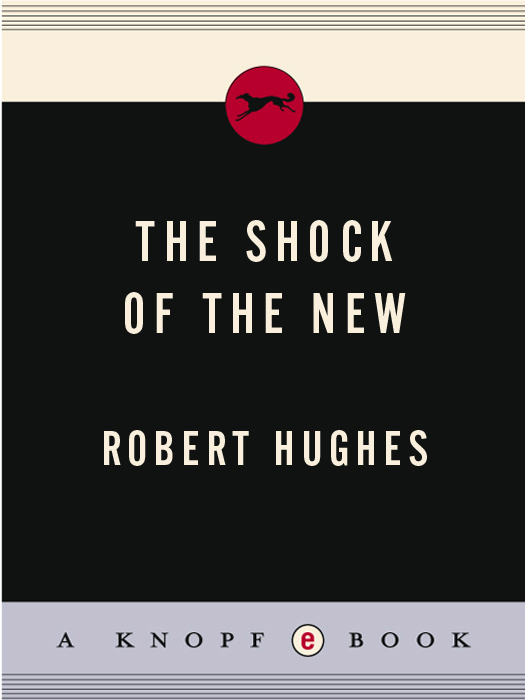
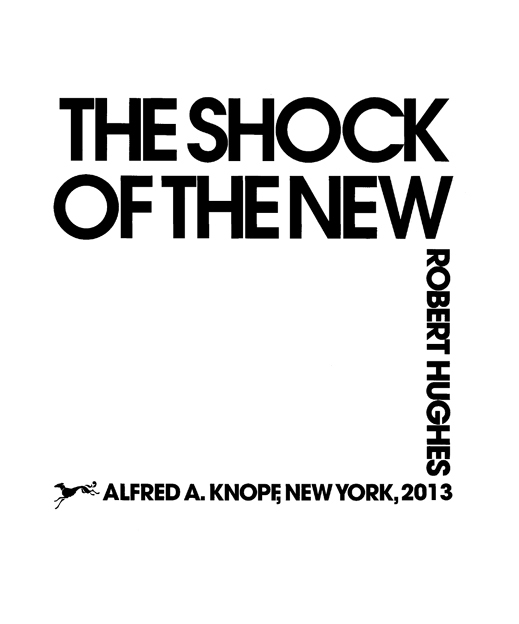
THIS IS A BORZOI BOOK
PUBLISHED BY ALFRED A. KNOPF, INC.
Copyright 1980, 1991 by Robert Hughes
Grateful acknowledgment is made to the following for permission to reprint from previously published material:
Faber and Faber Ltd.: Excerpt from MCMXIV by Philip Larkin. Reprinted by permission of Faber and Faber Ltd. from The Whitsun Weddings by Philip Larkin.
Editions Gallimard: Excerpts from Oeuvres de Grard de Nerval de la Bibliothque de la Pliade, Editions Gallimard 1952 and 1956. Excerpts from Oeuvres potiques de Guillaume Apollinaire de la Bibliothque de la Pliade, Editions Gallimard 1957.
Harcourt Brace Jovanovich, Inc., and Faber and Faber Ltd.: Excerpt from East Coker by T. S. Eliot is reprinted from Four Quartets by permission of Harcourt Brace Jovanovich, Inc., and Faber and Faber Ltd.; copyright 1943 by T. S. Eliot; copyright renewed 1971 by Esme Valerie Eliot.
John Murray (Publishers) Ltd. and Houghton Mifflin Company: Excerpt from Planters Vision by John Betjeman, from Collected Poems by John Betjeman. Reprinted by permission of John Murray (Publishers) Ltd., and Houghton Mifflin Company.
Punch and Rothco Cartoons, Inc.: Six lines of poetry from an issue of Punch published in the 1930s. Copyright Punch.
Random House LLC, and Faber and Faber Ltd.: Excerpt from Epitaph on a Tyrant by W. H. Auden. Copyright 1940 by W. H. Auden. Copyright renewed 1968 by W. H. Auden. From W. H. Auden: Collected Poems, edited by Edward Mendelson. Reprinted by permission of Random House LLC, and Faber and Faber Ltd.
Peter Newbolt: Excerpt from Vital Lampada by Sir Henry Newbolt. Reprinted by permission.
All rights reserved under International and Pan-American Copyright Conventions. Published in the United States by Alfred A. Knopf, Inc., New York. Distributed by Random House LLC, New York. Originally published in Great Britain by BBC Publications.
A Penguin Random House Company
Library of Congress Cataloging-in-Publication Data
Hughes, Robert, [date]
The shock of the new / by Robert Hughes. Rev. ed.
p. cm.
Includes bibliographical references.
eBook ISBN: 978-0-307-81555-2
Trade Paperback ISBN: 978-0-679-72876-4
1. Art, Modern 19th century. 2. Art, Modern 20th century.
I. Title.
N6447.H83 1991
709.04 dc20 89-43355 CIP
v3.1
TO VICTORIA, WITH LOVE
THE MECHANICAL PARADISE
THE FACES OF POWER
THE LANDSCAPE OF PLEASURE
TROUBLE IN UTOPIA
THE THRESHOLD OF LIBERTY
THE VIEW FROM THE EDGE
CULTURE AS NATURE
THE FUTURE THAT WAS
This book grew out of a television series I wrote and narrated for the BBC. From the first take to the last, The Shock of the New ate up three years of research, writing, and filming; and having addressed the camera from places as remote from one another, geographically and spiritually, as the Japanese bridge of Monets lily-pond in Giverny, the crematorium at Dachau, a roof in Braslia, the edge of the Grand Canyon, and the ruins of the Marquis de Sades chteau, I find adding up the air tickets that I covered more than a quarter of a million miles doing it. The soul, some Arabs believe, can only travel at the pace of a trotting camel. They are right.
From the start, the producers, directors, and I agreed that The Shock of the New should be, as Kenneth Clark put it more than ten years ago in his subtitle to Civilisation, a personal view of the art of our century. Eight hours sounds like a lot of air time, and it is; but it is totally inadequate to the task of doing a formal history of modern art on television, with every artist who did anything significant given his or her just place and explication. There are no footnotes on the Box. Instead, we decided to do eight essays about eight separate subjects that seemed important to an understanding of modernism. We would start with a programme about the blossoming of a sense of modernity in European culture roughly from 1880 to 1914 in which the myth of the Future was born in the atmosphere of millenarian optimism that surrounded the high machine age, as the nineteenth century clicked over into the twentieth century. We would finish with a film that tried to describe how art gradually lost that sense of newness and possibility, as the idea of the avant-garde petered out in the institutionalized culture of late modernism. In between, we would have six programmes dealing with six subjects visual essays on the relationship of painting, and to a lesser degree sculpture and architecture, to some of the great cultural issues of the last hundred years. How has art created images of dissent, propaganda, and political coercion? How has it defined the world of pleasure, of sensuous communion with worldly delights? How has it tried to bring about Utopia? What has been its relation to the irrational and the unconscious? How has it dealt with the great inherited themes of Romanticism, the sense of the world as a theatre of despair or religious exaltation? And what changes were forced on art by the example and pressure of mass media, which displaced painting and sculpture from their old centrality as public speech? Obviously, these are only some of the themes of modern art. Equally obviously, neither eight chapters nor eight programmes can cover them fully. But to tackle themes rather than a formal, sequential history seemed the best way to present at least some of this vast subject in so limited a frame, and to give a fairly wide panorama of the relations of art to ideas and to life in the modernist century.
So I did not try to get everyone in, and there is a long roster of artists whose work is not discussed (and often not even mentioned) in The Shock of the New. Little attention has been paid to sculpture, beyond the work of Brancusi, Picasso, and some of the Constructivists: no Rodin, Rosso, or Moore, no Gonzales, Calder, Anthony Caro, Louise Nevelson, or David Smith. In painting, artists as diverse and important as Vuillard, Hans Hofmann, and Balthus are left out. I can only plead, in modest self-defence, that their omission was not the result of ignorance but of the insuperable difficulty of fitting them into the narrative frame. In any case, it seemed better to look at a few artists quite closely than to try for a generalized and speckly tour dhorizon; and if that is advisable with the written word, it is an iron law of television.
The eight chapters of this book follow the eight programmes of the series quite closely in theme and general structure, and though they are much longer than the scripts about five times as long all the same I decided to use the extra space to flesh out the discussion rather than to introduce more characters. Television does not lend itself to abstract argument or lengthy categorization. If the making of the series had one repeated phrase that still echoes in my head, it was not heard on the soundtrack; the inexorable voice of Lorna Pegram, the producer, muttering: Its a clever argument, Bob dear, but what are we supposed to be looking at?
What the Box can do is show things, and tell. The inaccurate image on the screen is not the real painting, and does not substitute for the real experience of art any more than a reproduction on the printed page, an image inaccurately reassembled in terms of printers dots rather than electronic lines, can do so. No matter; we are used to the conventions of print reproduction of works of art, and the same will happen with television as more arts programming is done. Besides, the great virtue of TV is its power to communicate enthusiasm, and that is why I like it. I am not a philosopher, but a journalist who has had the good luck never to be bored by his subject.
Font size:
Interval:
Bookmark:
Similar books «The Shock of the new»
Look at similar books to The Shock of the new. We have selected literature similar in name and meaning in the hope of providing readers with more options to find new, interesting, not yet read works.
Discussion, reviews of the book The Shock of the new and just readers' own opinions. Leave your comments, write what you think about the work, its meaning or the main characters. Specify what exactly you liked and what you didn't like, and why you think so.

